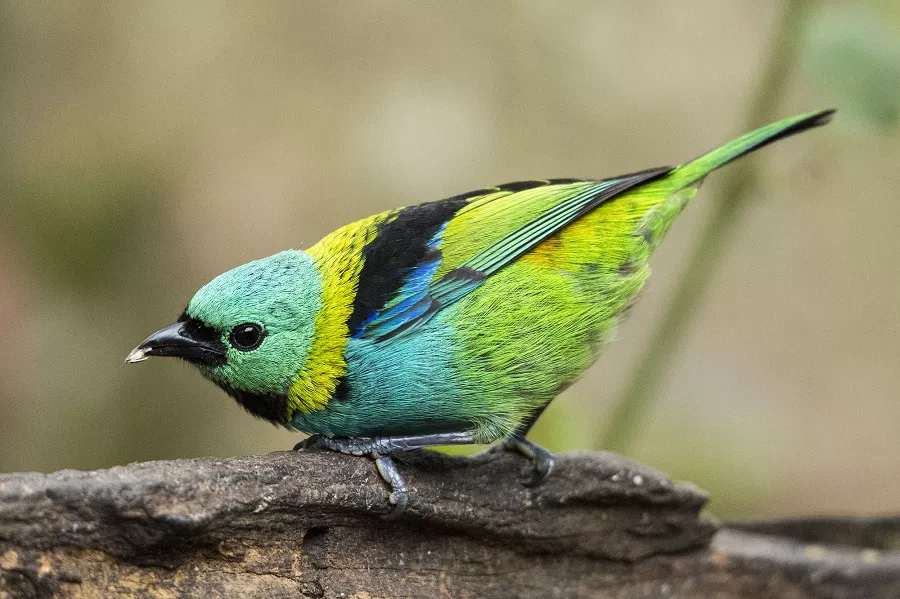The Green-headed Tanager, scientifically known as Tangara seledon, is a stunning and brightly colored bird species that belongs to the Thraupidae family. This charismatic avian beauty is native to the neotropical regions of South America, where it thrives in the lush canopies of rainforests. Its eye-catching plumage and melodious songs make it a favorite among birdwatchers and nature enthusiasts. In this article, we will explore the fascinating characteristics, behavior, habitat, and conservation efforts of the Green-headed Tanager, shedding light on its critical role in the ecosystem.
Physical Characteristics of Green-headed Tanager
The Green-headed Tanager is a visually stunning bird that stands out among its avian counterparts in the Neotropics. With an average length of 15 centimeters and a wingspan of approximately 21 centimeters, this species boasts a relatively small yet graceful build. One of its most striking features is the brilliant emerald-green plumage that envelops its head, giving rise to the common name “Green-headed Tanager.” Further down its body, the vivid colors continue, showcasing a dazzling contrast between the cobalt-blue back and the sunny yellow underparts. Additionally, the bird’s slender, pointed bill is perfectly adapted for its feeding habits, and its legs are designed to navigate through the dense vegetation of its habitat.
Habitat and Distribution
The Green-headed Tanager primarily inhabits the dense and lush rainforests of the Neotropics, encompassing the Amazon Basin, Central America, and parts of the Andean region. This habitat preference is attributed to the bird’s need for a constant supply of fruits, insects, and nectar, which are abundantly available in these tropical ecosystems. The Green-headed Tanager is often found at various altitudes, ranging from sea level to as high as 1,800 meters above it, depending on its geographical location. It displays a high level of adaptability, allowing it to thrive in diverse environments such as montane forests, secondary growths, and even in well-preserved urban parks.
Behavior and Feeding Habits
The behavior of Green-headed Tanager is as captivating as its appearance. These social birds are often seen foraging in small groups, making use of their keen eyesight and agility to navigate through the dense foliage in search of food. Their diet mainly consists of a diverse array of fruits, berries, insects, and flower nectar. The Green-headed Tanager plays a crucial role in the ecosystem by aiding in seed dispersal and pollination, thereby contributing to forest regeneration and the maintenance of biodiversity. This avian species also partakes in important symbiotic relationships with specific plant species, solidifying its place as an essential ecological link.
Breeding Patterns and Reproduction
During the breeding season, which varies across the species’ range, The Green-headed Tanager forms monogamous pairs. Males are known for their elaborate courtship displays, wherein they demonstrate their vibrant plumage to attract potential mates. The nesting process typically involves the female constructing a cup-shaped nest from twigs, leaves, and moss, often positioned on tree branches hidden away from potential predators. Both parents contribute to incubating the eggs and feeding the chicks once they hatch. The breeding success of Green-headed Tanager is highly dependent on the availability of food resources and suitable nesting sites, making them vulnerable to habitat destruction and other anthropogenic impacts.
Vocalizations
The Green-headed Tanager is known for its captivating vocalizations. The male emits a variety of songs, ranging from melodious and soft whistles to more complex and elaborate melodies. These vocalizations serve multiple purposes, including attracting mates, defending territories, and communicating with their offspring. The repertoire of songs may vary slightly among different populations, and research continues to unveil the extent of vocal diversity within the species.
Conservation Status and Threats
Despite its visually striking appearance, the Green-headed Tanager faces several threats that jeopardize its survival. Deforestation and habitat loss are among the most significant challenges this species encounters due to the expansion of agriculture, logging, and urbanization in the Neotropics. As their natural habitat shrinks, their access to food sources diminishes, affecting their ability to raise healthy offspring. Additionally, illegal capture for the pet trade and climate change-induced alterations in their range further add to their vulnerability.
Conservation Efforts and Strategies
Efforts to conserve the Green-headed Tanager and its habitat are of utmost importance to ensure the continuation of this stunning avian species. Various organizations, governments, and conservationists have been actively involved in safeguarding the Green-headed Tanager and its ecosystem. Initiatives include the establishment of protected areas, reforestation projects, and community-based conservation programs that involve local communities in safeguarding their natural surroundings. Additionally, raising awareness about the significance of these birds and the importance of preserving their habitats remains essential in garnering public support and involvement.
Conclusion
In conclusion, the Green-headed Tanager, or Tangara Seledon, is a remarkable avian species that holds significant ecological value within the Neotropics. Its striking appearance, behavior, and contributions to the ecosystem make it a focal point of interest for ornithologists and nature enthusiasts. However, the Green-headed Tanager faces numerous challenges due to habitat loss, deforestation, and other human-induced threats. Conservation efforts, supported by scientific research, public awareness, and community involvement, are crucial to ensuring the survival of this exquisite species for future generations. Through concerted actions and dedication to its preservation, we can strive to maintain the splendor of Green-headed Tanager and safeguard the rich biodiversity of the Neotropics.


 Facebook
Facebook  Instagram
Instagram  Youtube
Youtube 